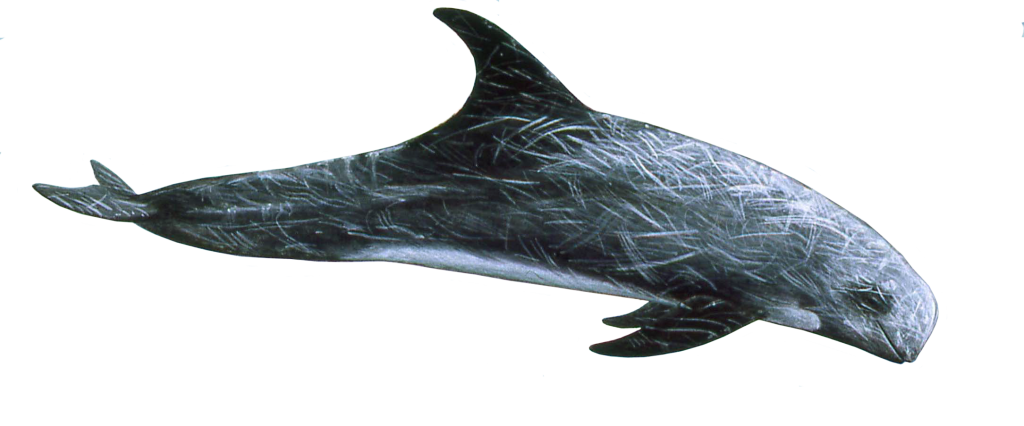Grampus
Family: Delphinidae
Genus: Grampus
Species: G. griseus (G. Cuvier, 1812)
One of the larger dolphins, Risso’s is stocky from its head to its large dorsal fin; thereafter its body tapers quickly, giving the animal an unusual profile. Risso’s may be a particularly aggressive or territorial dolphin; the animals’ bodies are often covered with scratches that match the pattern of their teeth.
The dolphin known as Pelorus Jack was probably a Risso’s dolphin. Between 1888 and 1912 this dolphin faithfully accompanied ships crossing Cook Strait at Pelorus Sound between New Zealand’s two main islands. On one occasion someone shot at Jack from a ferryboat, and he disappeared for about six months. When the dolphin reappeared, he resumed guiding ships — except that ferry — across the strait.
Physical Description: The stocky body becomes slender behind the dorsal fin. The large melon is divided by a vertical indentation running down the forehead almost to the mouth. The beak is not visible.
Color: Dark gray with light gray patches on ventral region. Juveniles are lighter gray. Older males often show white scarring all over the body, presumably from confrontations with other Risso’s dolphins; scarring increases with age and some individuals are almost entirely white from it.
Fins and Flukes: The tall, prominent dorsal fin, situated at the midback region grows to 15 inches (38 cm) and it falcate and rounded at the tip. Flippers and flukes are long and pointed; flukes have a definite median notch.
Length and Weight: Risso’s Dolphins reach 14 ft (4.3 m) and 1,500 lb (680 kg).
Teeth: Teeth are absent in the upper jaw; lower jaw contains 3 to 7 large, conical teeth per side.
Feeding: Primarily cephalopods, also small fish.
Breathing and Diving: Risso’s dolphins have a barely discernible blow and often make spectacular twisting and rolling leaps from the water as they swim. They also raise their head above the water when swimming around small boats.
Mating and Breeding: Calves 5 ft (1.5 m) long at birth become sexually mature at about 10 ft (3 m).
Herding: Herds from 5 to several hundred animals have been observed.
Distribution: Worldwide in tropical to temperate seas.
Migration: Seasonal North Atlantic migrations to higher latitudes have been suggested.
Natural History Notes: Risso’s dolphins have been observed in the presence of northern right whale dolphins, Pacific whitesided dolphins and short-finned pilot whales. They prefer deep-sea regions. Risso’s dolphins are thought to live to at least 20 years of age.








